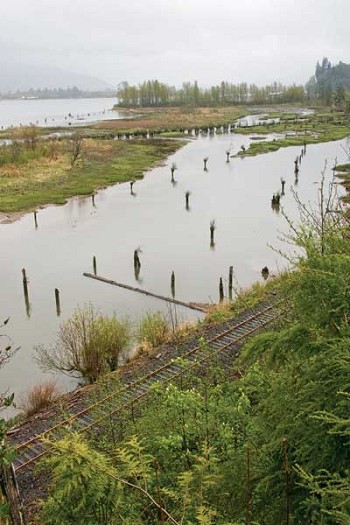forum
library
tutorial
contact

Numerous Solid Reasons to Reject LNG
by Stephen Glucoft, CommentaryThe Daily News, November 16, 2008
|
the film forum library tutorial contact |

|
Numerous Solid Reasons to Reject LNG
by Stephen Glucoft, CommentaryThe Daily News, November 16, 2008 |
 My main reason for opposing the Bradwood Landing Liquid Natural Gas terminal is its location. Placing it where the Columbia River is narrowest in the Lower Columbia Basin increases the possibility of injuries if there is an accident. A few years ago the federal government changed regulations to reduce the "circle of danger" around an LNG plant. We need to reinstate the larger distance and prevent the plant from being built.
My main reason for opposing the Bradwood Landing Liquid Natural Gas terminal is its location. Placing it where the Columbia River is narrowest in the Lower Columbia Basin increases the possibility of injuries if there is an accident. A few years ago the federal government changed regulations to reduce the "circle of danger" around an LNG plant. We need to reinstate the larger distance and prevent the plant from being built.
The Bradwood terminal will also destroy 46 acres of habitat for endangered salmon by dredging the Clifton Channel and then using it for taking on and discharging water. Past history has shown that preserving original habitat is generally more effective than trying to mitigate its destruction. Consider the millions of dollars spent on conserving salmon; we should not build a project that will do the opposite.
Beyond the problems of the site, importing LNG is controversial. The current national focus on developing non-polluting energy sources such as solar and wind is crucial to avoiding the worst-case scenarios of climate change. Until these new technologies are brought on-line, we must use fossil fuels that pollute as little as possible, and natural gas produces the least carbon dioxide. However, LNG is less "green" than natural gas because of the energy used to cool, transport, and re-gasify it. Some estimates say using LNG creates the same total amount of pollution as burning coal.
In the short- and long-term, the Pacific Northwest probably does not need to import LNG. In the near future, only a small part, if any, of the gas imported to Bradwood will be used here. The biggest market is in California, and NorthernStar Gas Inc. plans to build pipelines that will connect to California. California has rejected all proposed LNG terminals, but if the terminal is here, it will cost more to get the gas to California. Most important for us, the Pacific Northwest will bear the safety and environmental costs while Californians reap the benefits.
In the long-term, natural gas sources will be abundant here. Besides the huge supply in the Rockies, just last year there were new gas discoveries off the Oregon coast. We may not have to import LNG gas until well into the century Stephen Glucoft or never.
Up to now the federal government has not considered these issues when locating LNG terminals. Before 2005, there were five LNG plants in the U.S. Since the Energy Policy Act of 2005 gave authority to the Federal Energy Regulatory Commission to site LNG terminals, FERC has approved or is in the process of approving 40 more. Energy analysts expect many fewer will be constructed. However, according to FERC's Web site, its task is to approve LNG plants, and the market will determine which are built. California's rejection of LNG terminals means that pure market forces are being disrupted, but when elected representatives in Oregon asked FERC for an analysis of the need for LNG in our region, their requests were denied.
We cannot continue to be at the mercy of states responding to their citizens' particular concerns or of companies reacting to short-term market forces. Instead, we need national policies for long-term regional energy supplies. As much as possible, we should plan for efficient, stable and local energy sources that minimize danger to people as well as environmental destruction and pollution. One principle should be to locate energy plants near end-users. Another should be to use federal and state funds to spur development of local sources, both fossil fuel and non-polluting.
For 60 years, the Pacific Northwest has benefited from government investment in hydropower that began with grand-scale planning in the 1930s. We need the same kind of long and wide vision to plan energy sources for the next century.
learn more on topics covered in the film
see the video
read the script
learn the songs
discussion forum
